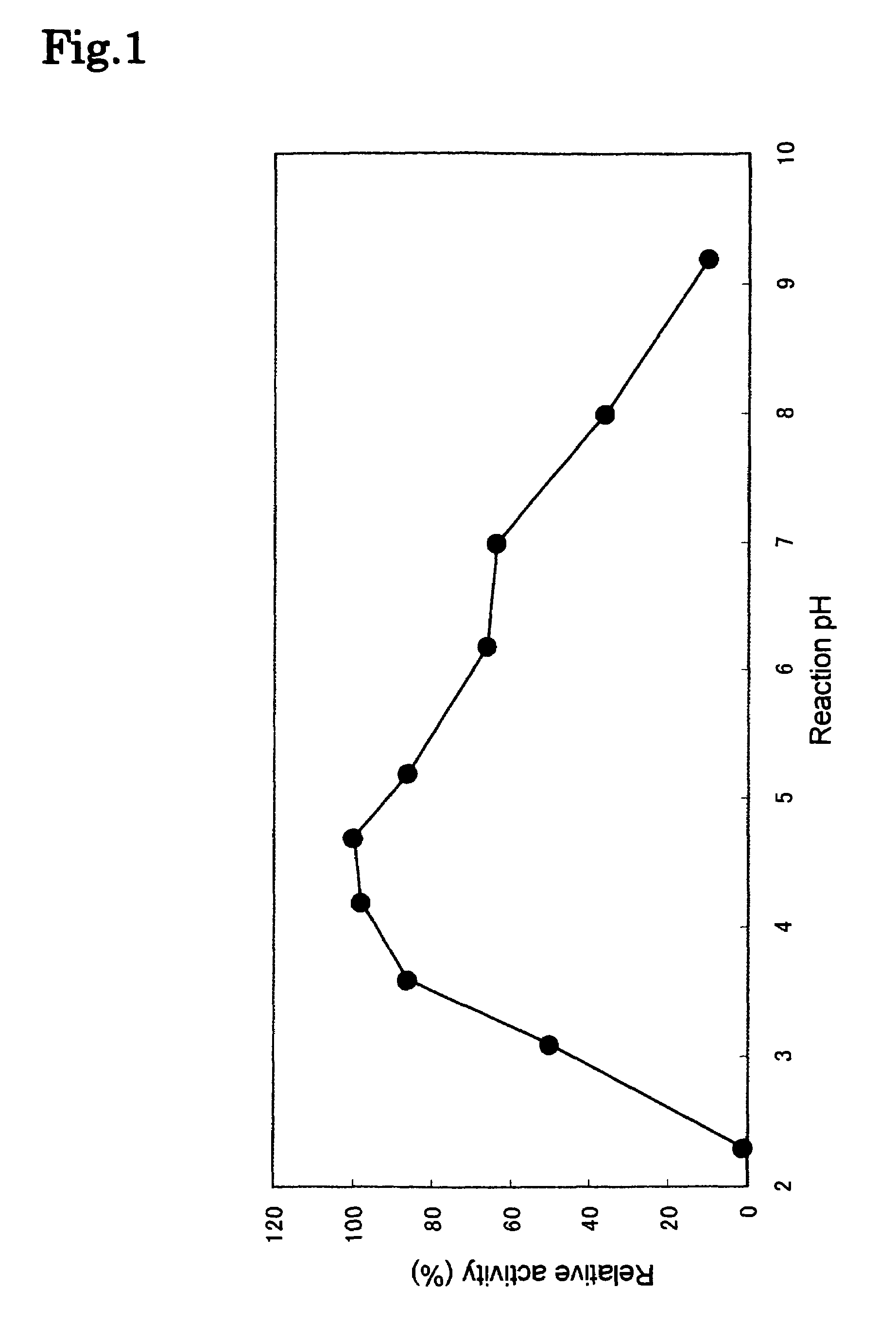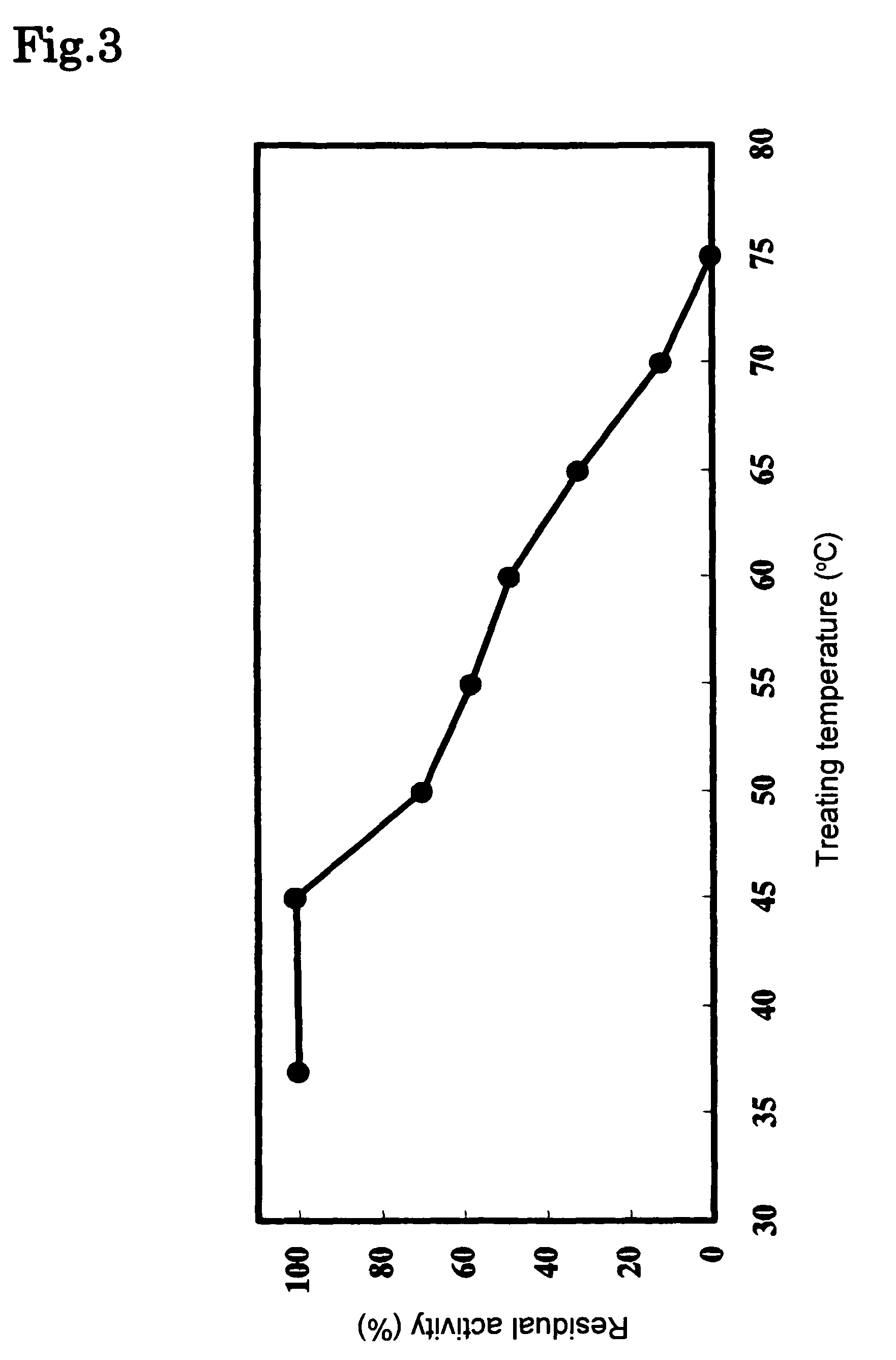Phospholipase C enzyme(s)
a phospholipase and enzyme technology, applied in the field of phospholipase c enzymes, can solve the problems of deteriorating the properties of foods, unsuitable for food industries, and preparations from animals cannot be accepted, and achieve excellent safety
- Summary
- Abstract
- Description
- Claims
- Application Information
AI Technical Summary
Benefits of technology
Problems solved by technology
Method used
Image
Examples
example 1
Purification of Phospholipase C Enzyme(s) from Aspergillus oryzae Strain FERM BP-10200
1) Preparation of a Crude Enzyme Solution
[0173]To a 500 ml vol. Erlenmeyer flask (seed flask) containing 100 ml of sterilized medium having the composition in Table 2, 1 ml of 5% filter-sterilized sodium deoxycholate solution was added and Aspergillus oryzae strain FERM BP-10200 was inoculated, and shaking culture was carried out at 170 rpm and at 26° C. for 7 days.
[0174]
TABLE 2MediumPolypeptone 40 gYeast extract 5 gDipotassium hydrogen phosphate0.2 gMagnesium sulfate0.5 gPurified water added to adjust the volume to 1,000 ml.
[0175]After culture, centrifugation was carried out at 10,000×G and at 4° C. for 10 minutes. The obtained supernatant was used as a crude enzyme solution.
2) Method for Measuring Enzyme Activity
[0176]The hydrolyzing activity of the phospholipase C enzyme(s) was measured as follows:
Hydrolysis Reaction of Lecithin
[0177]To 60 μl of a substrate solution in which 1.5 g of egg yolk ...
example 2
Purification of the Phospholipase C Enzyme(s) from Aspergillus tamarii Strain IAM 13907
1) Preparation of a Crude Enzyme Solution
[0185]To a 500 ml vol. Erlenmeyer flask (seed flask) containing 100 ml medium of which composition is indicated in Table 2, 1 ml of 5% filter-sterilized sodium deoxycholate solution was added, and Aspergillus tamarii strain 13907 was inoculated, and then shaking culture was carried out at 170 rpm and at 26° C. for 5 days. After culture, centrifugation was carried out at 10,000×G and at 4° C. for 10 minutes. The obtained supernatant was used as a crude enzyme solution.
2) Preparation of a Purified Enzyme Solution
[0186]A purified enzyme solution was obtained by carrying out purification procedures in the same manner as in Example 1.3).
3) Determination of Molecular Weight of the Purified Enzyme
[0187]Molecular weight was determined in the same manner as in Example 1.4).
[0188]The purified enzyme showed a single band at molecular weight of approximately 87,000.
example 3
Purification of the Phospholipase C Enzyme(s) from Aspergillus oryzaes Strain NBRC 4190
1) Preparation of a Crude Enzyme Solution
[0189]To a 500 ml vol. Erlenmeyer flask (seed flask) containing 100 ml of sterilized medium of which composition is indicated in Table 3, Aspergillus oryzaes strain NBRC 4190 was inoculated, and shaking culture was carried out at 170 rpm and at 26° C. for 7 days.
[0190]
TABLE 3MediumFish meal50 gPurified water added to adjust the volume to 1,000 ml.
[0191]After culture, centrifugation was carried out at 10,000×G and at 4° C. for 10 minutes. The obtained supernatant was used as a crude enzyme solution.
2) Preparation of a Purified Enzyme Solution
[0192]600 ml of the crude enzyme solution obtained in 1) were dialyzed 5 times for every 12 hours in 8,000 ml of 10 mM Tris-HCl buffer solution (pH 7.5). This was added and adsorbed to a DEAE TOYOPEARL (TOSOH CORP.) column (2.2 cm in diameter×20 cm in length) equilibrated in advance with 10 mM Tris-HCl buffer solution (p...
PUM
| Property | Measurement | Unit |
|---|---|---|
| pH | aaaaa | aaaaa |
| pH | aaaaa | aaaaa |
| pH | aaaaa | aaaaa |
Abstract
Description
Claims
Application Information
 Login to View More
Login to View More - R&D
- Intellectual Property
- Life Sciences
- Materials
- Tech Scout
- Unparalleled Data Quality
- Higher Quality Content
- 60% Fewer Hallucinations
Browse by: Latest US Patents, China's latest patents, Technical Efficacy Thesaurus, Application Domain, Technology Topic, Popular Technical Reports.
© 2025 PatSnap. All rights reserved.Legal|Privacy policy|Modern Slavery Act Transparency Statement|Sitemap|About US| Contact US: help@patsnap.com



